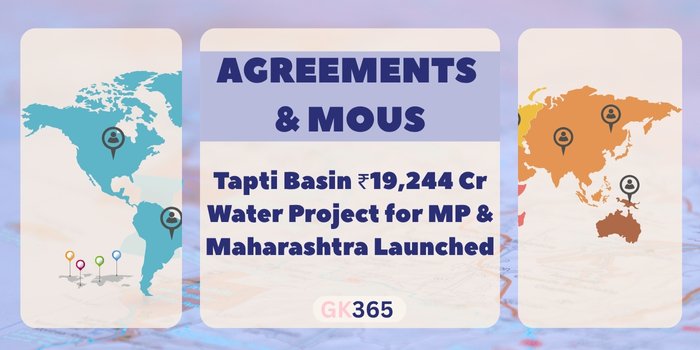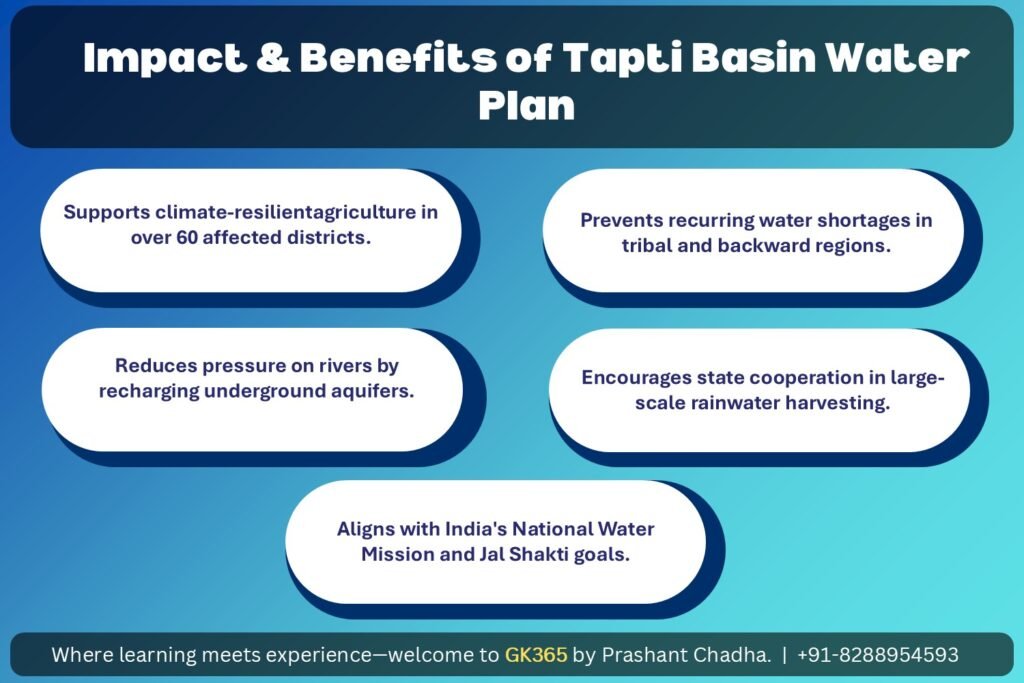Introduction
Madhya Pradesh and Maharashtra have signed an MoU for the Tapti Basin Mega Recharge Project. This project addresses water scarcity and promotes cooperation between the two States. Claimed to be the world’s largest river recharge effort, it aims to improve irrigation, ensure drinking water supply, and support climate readiness. With an estimated cost of ₹19,244 crore and likely 90% Central funding, the project targets long-term improvements in farming, groundwater, and regional growth.
Table of Contents
- What is the Tapti Basin Mega Recharge Project?
- Key Highlights of the Project
- Geographical Coverage and Beneficiary Districts
- Objectives and Features
- Historical Context and Background
- Significance and Expected Benefits
- Environmental and Economic Impact
- Challenges and Future Outlook
- FAQs
- Conclusion: A Milestone in Water Security
- Key Takeaways Table
What is the Tapti Basin Mega Recharge Project?
The Tapti Basin Mega Recharge Project is a large inter-State effort focused on replenishing the Tapti river basin. It aims to improve irrigation and ensure water availability in parts of Southern Madhya Pradesh and Northern Maharashtra. Rather than relying on large dams, the plan uses river recharge techniques, making it less intrusive and more sustainable.
Key Highlights of the Project
- States Involved: Madhya Pradesh and Maharashtra
- MoU Signed: May 10, 2025
- Venue: Bhopal, during the Inter-State Control Board meeting
- Estimated Cost: ₹19,244 crore (2022–23 estimates)
- Proposed Central Funding: 90% (National Project status)
- Water Allocation:
- Total: 31.13 TMC
- Madhya Pradesh: 11.76 TMC
- Maharashtra: 19.36 TMC
- Notable Feature: Projected to be the world’s largest river recharge scheme
- Next Meeting: October 2025
Geographical Coverage and Beneficiary Districts
The project covers 3,57,788 hectares across two States:
- Madhya Pradesh: Burhanpur, Khandwa (1,23,082 hectares)
- Maharashtra: Jalgaon, Akola, Buldhana, Amravati (2,34,706 hectares)
A total of 3,362 hectares in Madhya Pradesh will be used for infrastructure. No displacement or rehabilitation is needed, which eases public acceptance.
Objectives and Features
The project aims to:
- Secure drinking water for drought-prone districts
- Provide steady irrigation for over 3.5 lakh hectares of farmland
- Recharge groundwater and reduce overuse of aquifers
- Handle inconsistent rainfall and support farming in tough conditions
Project Features:
- Uses river recharge instead of major dams
- Designed to avoid displacement
- Offers a durable water solution for Vidarbha and Khandwa
Historical Context and Background
Plans to recharge the Tapti Basin go back to the 1990s, first suggested when Devendra Fadnavis was Nagpur’s Mayor. The Inter-State Control Board last met in 2000. Its 2025 revival signals renewed political and administrative focus on water issues in the region.
Significance and Expected Benefits
- Encourages State-level teamwork on shared water issues
- Improves farm output and reduces distress in drought-hit zones
- Supports steady water supply for farming-based economies
- Restores natural water balance and reduces pressure on groundwater
Environmental and Economic Impact
This is a low-displacement project with broad ecological benefits. By refilling rivers and easing groundwater demand, it helps protect biodiversity, retain soil moisture, and prepare farms for changing weather patterns.
Challenges and Future Outlook
- Central funding is expected but not confirmed
- River recharge at this scale needs strong planning and expertise
- Coordination between States and agencies may delay progress
- The next board meeting in October 2025 will set timelines and guide the next steps
FAQs
- What is the estimated cost of the project?
₹19,244 crore, based on 2022–23 estimates. - Which States are involved?
Madhya Pradesh and Maharashtra. - How much water will be used?
31.13 TMC in total (MP: 11.76 TMC, MH: 19.36 TMC). - Why is this project unique?
It avoids displacement and focuses on eco-friendly river recharge. - What is the next major step?
The Inter-State Board meets in October 2025 to finalize plans.
Conclusion: A Milestone in Water Security
This project goes beyond infrastructure. It shows how two States can work together on water management. It aligns with India’s broader goals of protecting crops, preparing for climate shifts, and sharing resources wisely.
India needs clear, shared strategies for its water future. Projects like this set the tone. For updates on such efforts, follow GK360.in.
Key Takeaways Table
| Category | Details |
|---|---|
| Project Name | Tapti Basin Mega Recharge Project |
| States Involved | Madhya Pradesh and Maharashtra |
| MoU Signed On | May 10, 2025, at Inter-State Control Board meeting in Bhopal |
| Estimated Cost | ₹19,244 crore (based on 2022–23 estimates) |
| Funding Proposal | 90% Central Government support (expected under National Project status) |
| Water Allocation | Total: 31.13 TMCMP: 11.76 TMCMH: 19.36 TMC |
| Geographic Coverage | 3,57,788 hectares:MP – Burhanpur, Khandwa (1.23 lakh ha)MH – Jalgaon, Akola, Buldhana, Amravati (2.34 lakh ha) |
| Key Features | – Uses river recharge methods instead of major dams- No displacement- Eco-friendly water conservation |
| Objectives | – Ensure irrigation- Secure drinking water- Recharge groundwater- Build climate resilience for farmers |
| Historical Roots | First proposed in 1990s; revived in 2025 after last Inter-State meeting in 2000 |
| Significance | – Largest such river recharge scheme globally- Supports Vidarbha and Khandwa agriculture |
| Environmental Benefits | Preserves biodiversity, improves soil moisture, reduces aquifer stress, mitigates climate effects |
| Challenges | – Central funding pending confirmation- Coordination and technical execution required- October 2025 meeting to finalize roadmap |



